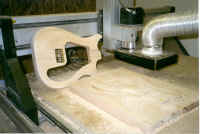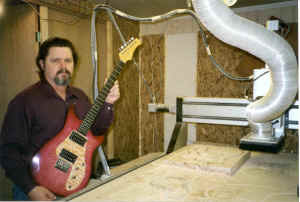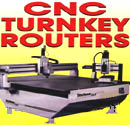CNC
Router Cuts New Product Development Time From 2 Months to 2 Days At Dodge Guitar
By Rick Dodge
President
Dodge Guitar Company
Tallahassee, Florida
 Switching from power tools to a
CNC router helped us reduce the time required to develop new guitars from two months to
two days. Reducing product development time has made the company more profitable and made
it possible to introduce products for smaller market niches that would have been too
expensive to address in the past. It used to take two weeks to build the prototype for a
new guitar with most of the time being occupied in building templates. Problems with the
initial design were always discovered, which required a long iterative process that
involved making up to a dozen prototypes to resolve. A new CNC router dramatically
streamlines this process by allowing us to develop electronic prototypes in which we can
check the fit of critical components. As soon as we have completed our design on a
personal computer, the machine produces the guitar without the need to make templates,
saving huge amounts of time. Switching from power tools to a
CNC router helped us reduce the time required to develop new guitars from two months to
two days. Reducing product development time has made the company more profitable and made
it possible to introduce products for smaller market niches that would have been too
expensive to address in the past. It used to take two weeks to build the prototype for a
new guitar with most of the time being occupied in building templates. Problems with the
initial design were always discovered, which required a long iterative process that
involved making up to a dozen prototypes to resolve. A new CNC router dramatically
streamlines this process by allowing us to develop electronic prototypes in which we can
check the fit of critical components. As soon as we have completed our design on a
personal computer, the machine produces the guitar without the need to make templates,
saving huge amounts of time.
Dodge Guitars has developed a
patented modular system that allows the player to replace all of the electronic components
of the guitar in seconds, providing unlimited sound possibilities. They can switch from a
three single coil Stratocaster configuration to a twin single coil Telecaster setup to a
dual humbucker Les Paul configuration, all in the same guitar, in a matter of seconds.
Each interchangeable module contains the complete electronics for the guitar, including
pickups, switches, knobs and jacks. Active electronics or any specialty pickup
combination, including MIDI wiring, can be incorporated into a module. The sustain is
comparable to any other well-crafted electric guitar.
Challenge of a modular
system
Building a modular guitar
represents a considerable challenge from a design standpoint. The module, a hollow box
that inserts through the back of the guitar, must be perfectly aligned with the guitar
strings in order to provide the proper sound. Insuring that this level of accuracy is
achieved with every module is a challenging task. In the past, when the company used power
tools to build its guitars, it was very
difficult to establish the proper relationships between the different components. Building
a prototype first required that about a dozen separate templates be created to produce the
front and back of the guitar body, the neck, and other parts. Producing all these
templates and building the prototype took about two weeks with a power router with a
bearing bit.
 Once the prototype was
completed, we finally had the opportunity to check it against what we were trying to make.
Because the process of making the templates provided no opportunity to check for errors,
there were always a considerable number of problems with the first one. For each problem
we had to create a new template and often a problem affected more than one template. It
was necessary to build an average of 10 prototypes before we achieved the demanding levels
of dimensional performance required to achieve management approval to begin production.
The amount of time involved in developing new products meant that we could only address
relatively large market niches where they were certain that sales volume would be high
enough to pay back the development costs. Once the prototype was
completed, we finally had the opportunity to check it against what we were trying to make.
Because the process of making the templates provided no opportunity to check for errors,
there were always a considerable number of problems with the first one. For each problem
we had to create a new template and often a problem affected more than one template. It
was necessary to build an average of 10 prototypes before we achieved the demanding levels
of dimensional performance required to achieve management approval to begin production.
The amount of time involved in developing new products meant that we could only address
relatively large market niches where they were certain that sales volume would be high
enough to pay back the development costs.
Search for an alternative
In an effort to develop
products faster and at a lower cost, Dodge Guitar management investigated various
computerized numerical control (CNC) cutting tools. The goal was to create and validate
the design on the computer in order to eliminate or at least streamline the lengthy
prototyping process. At first, we considered a traditional CNC machine. These machines,
made by companies such as Bridgeport, start at $50,000, not including the CNC programming
software. To get a model with a large-enough working area, Dodge Guitar would have had to
buy one of the larger machines costing at least twice that. Another alternative would have
been a low-cost router that uses racks, acme screws and stepper motors but it would have
been limited to low speeds and shallow cuts and probably would have suffered from
vibration that would hurt part finish. Then they heard about a new type of gantry router
that has a large cutting area and most of the features of much more expensive machines
such as ball screws, servo motors and a heavy frame yet was still available at a low
price.The supplier of the Techno Series III, Techno-Isel, New Hyde Park, New York, has
been around for longer than any of the other low-cost router manufacturers and managers
heard they had a good reputation for service and support.
Dodge Guitars ended up purchasing the machine from their local dealer, CWS
Associates, Inc., Newport Richey, Florida. The price was less than $26,000 including CNC
programming software. Its working area of 40 inches by 48 inches with a Z-axis height of 6
inches is large enough to set up multiple guitars at once.
 The new machine made it
possible for Dodge to adopt an entirely new approach to new product development. Now, the
firm’s engineers begin the design process by using the computer aided design (CAD)
capabilities of Mastercam to sketch out their design on the computer in three dimensions.
By manipulating their model on the screen, panning, zooming and rotating, they are usually
able to validate all critical dimensional relationships before they even begin to cut
wood. In their most recent project, a new bass guitar, for example, they digitized an
existing guitar body, then made about 50 changes to their original design on the computer
prior to building the prototype. The best feature of the new approach is that a typical
dimensional change can be made in two minutes on the computer as compared to half a day to
build an accurate template. To provide a final validation step, they put a marker in the
machine spindle and used it to trace the outline of the program on posterboard. The new machine made it
possible for Dodge to adopt an entirely new approach to new product development. Now, the
firm’s engineers begin the design process by using the computer aided design (CAD)
capabilities of Mastercam to sketch out their design on the computer in three dimensions.
By manipulating their model on the screen, panning, zooming and rotating, they are usually
able to validate all critical dimensional relationships before they even begin to cut
wood. In their most recent project, a new bass guitar, for example, they digitized an
existing guitar body, then made about 50 changes to their original design on the computer
prior to building the prototype. The best feature of the new approach is that a typical
dimensional change can be made in two minutes on the computer as compared to half a day to
build an accurate template. To provide a final validation step, they put a marker in the
machine spindle and used it to trace the outline of the program on posterboard.
Cutting prototype in an hour
or two
 With the design fully
validated, we were ready to produce the prototype. Note that there was no need to make
templates first, so it only took an hour or two to cut out the pieces for a prototype. The
Techno machine's .0002 inch resolution and repeatability and 0.003 inch absolute accuracy
are considerably better than what Dodge’s craftspersons were able to achieve with
power tools. The Techno machine's accuracy is the result of several features inherent to
the table, such as the use of ball screws and servo motors. For example, anti-backlash
ball nuts permit play-free motion that makes it possible to produce accurate curves and
inlays and a terrific finish. The Techno router uses ballscrews that ensure longer life
and greater rigidity during the life of the system because of the reduced wear as compared
to ACME screws and nuts or rack and pinion systems. Cut quality and longevity were
important considerations. With the design fully
validated, we were ready to produce the prototype. Note that there was no need to make
templates first, so it only took an hour or two to cut out the pieces for a prototype. The
Techno machine's .0002 inch resolution and repeatability and 0.003 inch absolute accuracy
are considerably better than what Dodge’s craftspersons were able to achieve with
power tools. The Techno machine's accuracy is the result of several features inherent to
the table, such as the use of ball screws and servo motors. For example, anti-backlash
ball nuts permit play-free motion that makes it possible to produce accurate curves and
inlays and a terrific finish. The Techno router uses ballscrews that ensure longer life
and greater rigidity during the life of the system because of the reduced wear as compared
to ACME screws and nuts or rack and pinion systems. Cut quality and longevity were
important considerations.
Dodge also found that all the
big expensive routers used the same ballscrews and servo motor design found on the Techno
machines; but none of the expensive routers offered stepper motor drives. Prototypes
produced by the new machine generally have few if any problems that need to be ironed out
because of the advance validation process performed on the computer. Any changes that do
need to be made can be done far more quickly than in the past. The engineer simply enters
the change in the three dimensional Mastercam model, then cuts a new part. In the new bass
guitar described earlier, only a few minor changes were required to the initial prototype.
This made it possible to complete the entire design process in only two days.
Product variants
One of the greatest benefits of
the new approach comes after the initial design is complete. Because the design is
produced in electronic format and the modeling process is largely automated, it’s
easy to modify the design either as an improvement or to create a product variant. In the
past, on the other hand, the amount of time required to make changes was high because
templates had to be built from scratch. For example, Dodge Guitars recently developed a
new line of left-handed guitars simply by producing mirror images of the computer models
of existing guitars. Left handed guitars are normally more expensive and there are few
choices available. The new CNC approach will let us offer any guitars we wish in
left-handed models.
In approximately 300 hours of
operation, Dodge Guitars has had no problems with the Techno machine. This is partly due
to the strength and rigidity of the table, which is constructed from extruded aluminum
profiles that provide easy clamping capability. The machine also has four ground and
hardened steel shafts and eight recirculating bearings in each axis. This shaft and
bearing system produces very smooth play-free motion and an extremely rigid system that
produces high-quality cuts.
As a
relatively new entrant to the guitar market, the CNC router has had a big impact on our
ability to compete with the market leaders. It has helped us develop an extensive product
line at a reasonable cost and allows us to produce a product that matches or exceeds all
other products in terms of accuracy and repeatability.
CAPTIONS:
1) Dodge
Guitars has developed a patented modular system that allows the player to replace all of
the electronic components of the guitar in seconds. Shown in foreground is an example of
one of Dodge's modules, including pickups, switches, knobs and jacks. Active electronics
or any specialty pickup combination, including MIDI wiring, can be incorporated into a
module.
2-3) Shown is guitar body produced by Dodge, ready for
insertion of modules.
4) A finished modular guitar from Dodge. The module,
a hollow box that inserts through the back of the guitar, is perfectly aligned with the
guitar strings in order to provide the proper sound. The sustain is comparable to any
other well-crafted guitar. |


